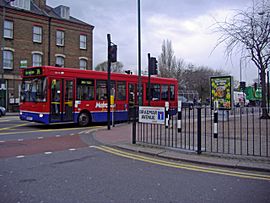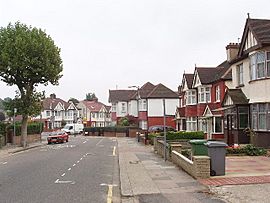Neasden facts for kids
Quick facts for kids Neasden |
|
|---|---|
 Messengers BAPS Shri Swaminarayan Mandir is Europe's first traditional Hindu stone temple. |
|
| OS grid reference | TQ215855 |
| London borough | |
| Ceremonial county | Greater London |
| Region | |
| Country | England |
| Sovereign state | United Kingdom |
| Post town | LONDON |
| Postcode district | NW2, NW10 |
| Dialling code | 020 |
| Police | Metropolitan |
| Fire | London |
| Ambulance | London |
| EU Parliament | London |
| UK Parliament |
|
| London Assembly |
|
Neasden is a lively area in northwest London, England. It's located in the middle of the London Borough of Brent. You can find it in the NW2 and NW10 postal areas. Neasden is close to famous places like Wembley Stadium and the Brent Reservoir, also known as the Welsh Harp. The reservoir and the River Brent form its borders with Kingsbury and Wembley.
Gladstone Park and the Dudding Hill line separate Neasden from Dollis Hill and Church End. The busy North Circular Road (A406) runs right through Neasden. To the west, you'll find the Neasden Underground Depot, the Brent Park shopping area, and the St Raphael's Estate. On the east side are Neasden tube station, the amazing Neasden Temple, and the old Neasden Power Station. Neasden is also famous because Bob Marley, the reggae superstar, lived here after moving from Jamaica. His house in The Circle even got a special blue plaque in 2012 to remember him.
Contents
Neasden's Story: A Journey Through Time
How Neasden Got Its Name
Neasden was first mentioned way back in AD 939 as Neasdun. Its name comes from two old English words: nēos, meaning 'nose', and dūn, meaning 'hill'. So, Neasden means 'the nose-shaped hill'. This name likely came from a hill in the area that looked like a nose. In 1750, it was called Needsden, and the spelling we use today came later.
From Countryside to Village
For a long time, Neasden was just a small countryside village on the western side of the Dollis Hill ridge. The land belonged to St. Paul's Cathedral. In the Middle Ages, the village had only a few small buildings around a green area. This green was near where the Neasden roundabout is now.
Early Landowners and Big Houses
From the 1400s to the 1600s, the Roberts family owned most of the land in Neasden. Thomas Roberts built Neasden House during the time of King Henry VIII. Later, in 1651, Sir William Roberts bought some church lands. Even when the lands went back to the Church, the Roberts family continued to lease them. Sir William made Neasden House even better, and by 1664, it was one of the biggest houses in the Willesden area.
In the 1700s, the Nicoll family became the main landowners in Neasden. By the 1800s, these farmers and coin makers at the Royal Mint owned Neasden House and much of the surrounding land.
A Quiet Hamlet Grows
By 1823, Neasden was still a quiet village. It had six small cottages, four larger houses or farms, a pub, and a smithy (a place where a blacksmith works with metal). These buildings were all grouped around the village green. One of the houses was The Grove, and another was The Grange, which was once an outbuilding of The Grove.
The Welsh Harp Reservoir
The Welsh Harp reservoir was finished in 1835. It burst its banks in 1841, causing some deaths. This reservoir changed the landscape a lot because damming the River Brent flooded many fields and meadows.
Horses and the RSPCA
In the early 1850s, about 110 people lived in Neasden. Horses were the main way to travel back then. As London grew, more and more horses were needed in the city. Neasden farms started focusing on raising horses for London. City work was hard on horses. So, in 1886, the RSPCA created the Home of Rest for Horses. Here, city horses could graze in the open for a few weeks for a small fee, helping them recover.
The Arrival of the Railway
The growth of Neasden really took off when the railway arrived. Neasden station opened on Neasden Lane in 1880. New homes were built for railway workers, especially around Village Way. The streets in this area were even named after Metropolitan Railway stations in Buckinghamshire.
Community Life and Sports
In 1883, a church called St Saviour's was built in the village. Its priest, Reverend James Mills, became a very important person in Neasden. He helped create a new church area called Neasden-cum-Kingsbury because the population was growing.
Before Mills arrived, Neasden only had fox hunting. But Mills started the Neasden Cricket Club and encouraged music groups. In 1893, a golf club opened at Neasden House. By 1891, Neasden had 930 people, with half living in the village. The Spotted Dog pub became a popular social spot.
More Railways and Industry
In 1893, the Great Central Railway got permission to connect its main line from Nottingham to the Metropolitan line. Trains ran to Marylebone station in London. The Great Central Railway built a depot in Neasden and homes for its workers. This area became a "singularly isolated and self-contained community" with its own school and a shop. It's now a special conservation area. The two railway communities had a big sports rivalry, even playing football matches every Good Friday. By the 1930s, the two railways employed over 1000 people.
Neasden Hospital was built in 1894 and closed in 1986. Before the First World War, Neasden was mostly farmland. By 1911, Neasden's population had grown to 2,074. Light industry started to appear along Neasden Lane by 1913.
Modern Development and World War II Secrets
In the 1920s, the building of the North Circular Road, a major road around London, brought more development. It opened in 1922–23. This new road, along with improvements for the 1924–25 British Empire Exhibition, helped Neasden become a new residential suburb. In 1930, part of Neasden House was pulled down. The last farm in Neasden was built over in 1935. The Ritz cinema opened in 1935, and the Neasden Shopping Parade opened in 1936, becoming the most modern in the area. Most of Neasden's older houses were demolished, except for The Grange. The Spotted Dog pub was rebuilt in a mock-Tudor style. Industries grew in the south of Neasden, and by 1949, over 13,000 people lived there.
The Post Office Research Station was nearby in Dollis Hill. Here, the Colossus computers, some of the world's first computers, were built in 1943-1944. Also, the Paddock wartime cabinet rooms, secret government bunkers, were built underneath it in 1939.
Neasden Power Station, which powered the Metropolitan Railway, closed and was taken down in 1968.
Neasden Today
After World War II, Neasden faced some challenges. A new underpass on the North Circular Road cut Neasden in half, making it harder for people to reach the shopping centre. Also, many industries closed in the 1970s. However, Neasden has continued to thrive thanks to new communities moving in and helping the local economy. The Neasden Depot is still the main place for storing and maintaining London Underground trains, especially for the Metropolitan line and Jubilee line. It's London Underground's largest depot and a big employer in the area.
Neasden in Books, TV, and Music
"The Loneliest Village in London"
Neasden was once called ‘the loneliest village in London’.
Private Eye Magazine
Neasden became quite famous thanks to the British satirical magazine, Private Eye. This magazine, which was once printed in Neasden, often uses the area as an example of a typical suburb. They use it to make fun of current events, famous people, and social trends. For example, they created a fake "University of Neasden." Their funny sports reports often feature a football team called Neasden F.C., who always lose. Their manager is "ashen-faced" Ron Knee, and their only two fans are Sid and Doris Bonkers.
Metro-land TV Show
Neasden was featured in the TV documentary Metro-land. In the show, Sir John Betjeman described Neasden as "home of the gnome and the average citizen." This was a funny reference to the many garden gnomes found in suburban front gardens. The background music for this part was a song called "Neasden" (1972) by William Rushton, which goes "Neasden/You won't be sorry that you breezed in."
BBC Radiophonic Workshop
In 1968, a composer named David Cain from the BBC Radiophonic Workshop created a funny spoof of old music. He imagined a group called the Schola Polyphonica Neasdeniensis, who played very old instruments like the fictional Shagbut, Minikin, and Flemish Clackett. This was broadcast on BBC Radio 3.
Athletico Neasden Football Team
Athletico Neasden was an amateur football team with mostly Jewish players. They played in the Maccabi (Southern) Football League in the 1970s and 1980s. Even though they were named after Neasden, they didn't actually play in the area. The team later joined with North West Warriors to form North West Neasden.
Neasden in Books
David Sutherland's children's book A Black Hole in Neasden tells a story about a secret gateway to another planet found in a Neasden back garden. Diana Evans's 2006 novel, 26a, describes the lives of twin girls of Nigerian and British background growing up in Neasden.
Dread Broadcasting Corporation
A pirate radio station called Dread Broadcasting Corporation (DBC) broadcast from a Neasden garden between 1981 and 1984. It's known as Britain's first black music radio station.
Dangermouse Cartoon
In the "Planet of the Machines" episode of the cartoon Dangermouse, Dangermouse and Penfold return to Neasden from another planet using the Baron's space time machine.
BBC Your News
Konnie Huq and Matt Cooke from BBC TV used to present the Your News programme from Neasden.
Getting Around Neasden
Fun Places to Visit in Neasden
- BAPS Shri Swaminarayan Mandir London: This amazing Hindu temple is in South Neasden.
- Brent Reservoir: A large reservoir, great for walks and spotting wildlife.
- Neasden Bunker: A secret alternative Cabinet War Room from World War II, located in North Neasden.
- Sufra & St. Raphael's Edible Garden: Community gardens that help people.
Nearby Areas
 |
Kingsbury, Wembley Park | Welsh Harp, West Hendon | Brent Cross Interchange |  |
| Wembley Park | Dollis Hill, Cricklewood | |||
(Underpass) |
||||
| Tokyngton | Church End, Stonebridge | Willesden |
Tube and Train Stations
Neasden station is on the Jubilee line. It's the main train station for a large area, besides Dollis Hill station, which is close by on the same line. The south part of St Raphael's Estate is near Stonebridge Park station. The north end of Neasden, near Staples Corner, is quite close to Hendon station. In the early 2020s, Brent Cross West station will open, becoming the closest Thameslink station for Neasden.
Famous People From Neasden
Many interesting people have connections to Neasden:
- Twiggy (a famous model and actress)
- Gerry Anderson (a producer, director, and writer, known for shows like Thunderbirds)
- Ginger Baker (a musician, drummer for Cream)
- Bert Elkin (a professional footballer)
- Diana Evans (a novelist)
- Mario Fabrizi (a film, TV, and radio personality)
- Vinny Feeney (a boxer)
- Judy Grinham (an Olympic swimmer)
- Charlie Kunz (a musician)
- Arthur Ted Powell (an artist)
- George the Poet (a spoken-word artist)
- William Roberts (a Member of Parliament)
- Jock Rutherford (a footballer)
- Raheem Sterling (a famous footballer)
- Gary Warren (an actor)
- Graham Young (known as "The Teacup Poisoner" - Note: This person is mentioned in the original text, but due to safety guidelines, no details about their actions are provided.)
- Mari Wilson (a singer)
- Angelos Epithemiou (a fictional character)
- Bob Marley (the legendary reggae singer)
- Chunkz (a social media personality and singer)




